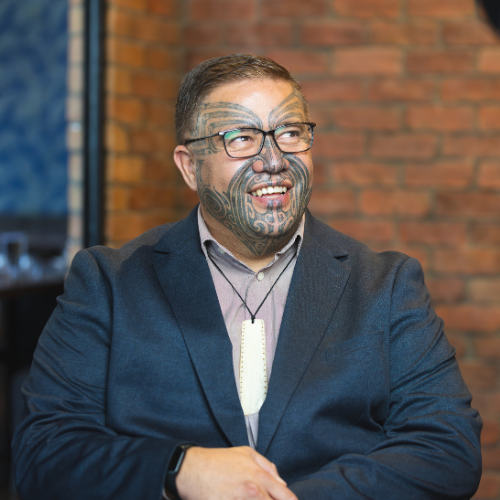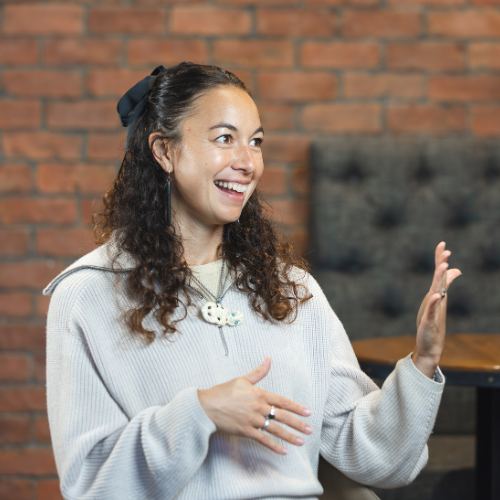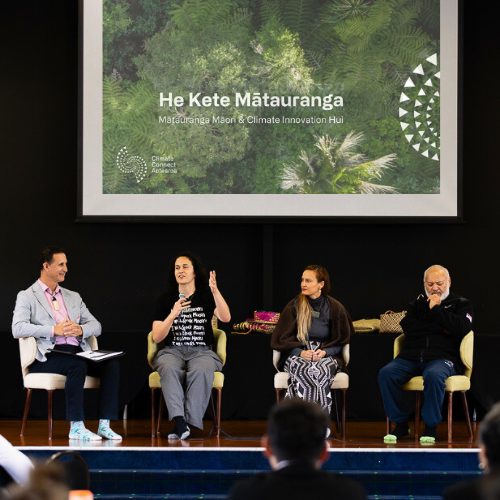
Waimarama Hawke
The Hui
After the success of the first He Kete Mātauranga hui in 2024, Climate Connect Aotearoa was honoured to host a two-day hui in March. Since the inception of He Kete Mātauranga, our kaupapa has been grounded in mātauranga Māori. We were privileged to welcome a group of 11 mātauranga Māori practitioners and scholars from te ao Māori, who led a range of kaupapa across the two days. With the intention of moving from theory to practice, we introduced eight new workshops that explored topics like the healing properties of Kawakawa (New Zealand native plant) and the maramataka (Māori lunar calendar) as a guide for wellbeing. Our keynote speakers and facilitators guided our wānanga under our three main themes of Mātauranga Māori, Taiao to Toi Māori and Te Anamata.

Te Puna Creative Hub
Mātauranga Māori – Tupuna wisdom
Che Wilson of Ngāti Rangi Whanganui, Tūwharetoa, Mōkai Pātea, Ngāti Apa and Ngā Rauru was our Mātauranga Māori keynote speaker. His kōrero was guided by the notion that reviving culture will revive nature. Che explored the contrast of theory and practice and emphasised the importance of our traditional ceremonies. He shared that our ancestors had to know how to read nature to survive and that we need to re-learn how to speak to and listen to our environment. He encouraged the audience to reclaim this innate way of being with the proverb – “kauaka e kōrero mō te awa, kōrero ki te awa”. This kōrero is about connecting to our taiao (environment) with our hands and feet, rather than just talking about it.

Che Wilson
“Kauaka e kōrero mō te awa, kōrero ki te awa.”
This was the perfect lead into the practical workshops to follow including ‘Rongoā’ (Māori remedies) with Eruini Hawke, ‘Maramataka’ with Ayla Hoeta and ‘Active Whakapapa’ with Tyler Taua-Gordon. Eruini led a workshop exploring the depth and diversity of rongoā Māori. Guided by mātauranga Māori, the session focused on Kawakawa, with participants learning how to prepare and make their own Kawakawa oil. Ayla delivered an intimate session exploring maramataka Māori as a framework for understanding natural rhythms and personal wellbeing. Participants created their own maramataka dials and learnt how to use them as a tool for observation. Tyler delivered an iwi-designed active whakapapa workshop alongside the Ōpanuku stream, highlighting locations and stories of significance to Te Kawerau ā Maki, the iwi mana whenua of the location of our hui, Te Kōpua Henderson.

Active Whakapapa with Tyler Taua-Gordon

Maramataka with Ayla Hoeta
Taiao to Toi Māori – Storytelling
Nikau Hindin of Ngai Tūpoto, Te Rarawa and Ngāpuhi was our ‘Taiao to Toi Māori’ keynote speaker. Nikau is a Māori artist who has spent the past decade reinvigorating the practice of aute in Aotearoa. Her keynote was shaped around the idea that storytelling and toi Māori (Māori arts) are synonymous. She described toi Māori as a method of storing knowledge, engaging with community and retaining and practicing mātauranga Māori. The innate connection between toi Māori and the environment was evident – in this case, through the process of growing and harvesting of aute. Nikau talked about toi Māori as a spiritual practice and likened it to our creation story, starting in Te Kore (the nothing), moving to Te Pō (the night) and eventually coming to the light, Te Ao Mārama.

Nikau Hindin
We presented three ‘Taiao to Toi Māori’ workshops including Waiata (song) with Majic Pāora, Waituhi (painting) with Raukura Turei and Te Reo Māori with Robbie Pāora. Majic led a waiata Māori session where she explored song as a tool for storytelling. She and the group then composed a waiata about our innate connection to the environment, with a focus on te ora o te wai – the wellbeing of water. Raukura delivered a hands-on waituhi workshop where participants got to create their own art pieces using soils, clays and onepū (sand) from Hikurangi, and the coast of Te Tai o Rēhua (Tasman Sea). Robbie took a te reo Māori centred workshop where participants learnt how to use pepeha (tribal identifiers), whakataukī (proverbs), and kīwaha (idioms) related to the taiao.

Waiata with Majic Pāora

Waituhi with Raukura Turei
Te Anamata – Reimagining a (K)new Future
Tina Porou of Ngai Tūpoto, Ngāti Porou, Ngāti Tūwharetoa, Ngāi Tāmanuhiri, Rongomaiwahine and Ngāti Rakaipaaka was our ‘Te Anamata’ keynote speaker. She opened with the kōrero that whakapapa is a dynamic and ever-changing thing. It represents a multitude of connections to people, to the environment and to atua (deities) – that was deliberately designed by our ancestors. In times of uncertainty, Tina reminded us that it is whakapapa that grounds us in what we do. A statement that captured the room was that places of great tension create transformative jumps. She mentioned the Māori land march and Bastion Point – movements that represent some of the greatest spaces of tension in te ao Māori which ultimately led to change. This provided hope in the context of our current political and environmental experiences and encouraged us to view this time of tension as an opportunity to create great change for our people and our taiao.
“Places of great tension create transformative jumps.”
The two ‘Te Anamata’ workshops included ‘Te Ao Matihiko’ with Dan Te Whenua Walker and ‘Environmental Law’ with Vicki Morrison-Shaw. Dan explored the role of artificial intelligence in te ao Māori and its applications to the environment and the potential for maintaining mana motuhake (self-determination) in the digital space. Vicki looked at the intersection of environmental law, Te Tiriti o Waitangi and mātauranga Māori – with a focus on how climate change is addressed within law.

Environmental Law with Vicki Morrison-Shaw

Te Ao Matihiko with Dan Te Whenua Walker
The value of mātauranga Māori
Mātauranga Māori as an ideology is something that Climate Connect Aotearoa has been exploring through the online hub. However, what stood out at He Kete Mātauranga this year was the importance of practice. It was evident that practical knowledge and experience is just as valuable as theory. This was greatly reflected in the keynotes, including our ‘Mātauranga Māori’ speaker, Che Wilson.
Che says, “In every whānau, there are people whose hands and feet have never lost the reo.” Despite not speaking te reo Māori, they are proficient in growing kūmara, reading the moon phases, understanding the medicinal properties of rākau (trees) and navigating waka hourua (double-hulled vessels).
One of the greatest takeaways is that we need practitioners and scholars. In te ao Māori, we are witnessing a resurgence of kaupapa and wānanga where the classroom is the taiao and the curriculum is mātauranga tūpuna. We now have a deeper understanding that this is the best way to learn about our environment. Climate Connect Aotearoa is incredibly proud to have created a space that embraces this kind of learning and looks forward to more opportunities to learn about the taiao – through the taiao.
To explore the programme from this year’s He Kete Mātauranga Hui, click here.


